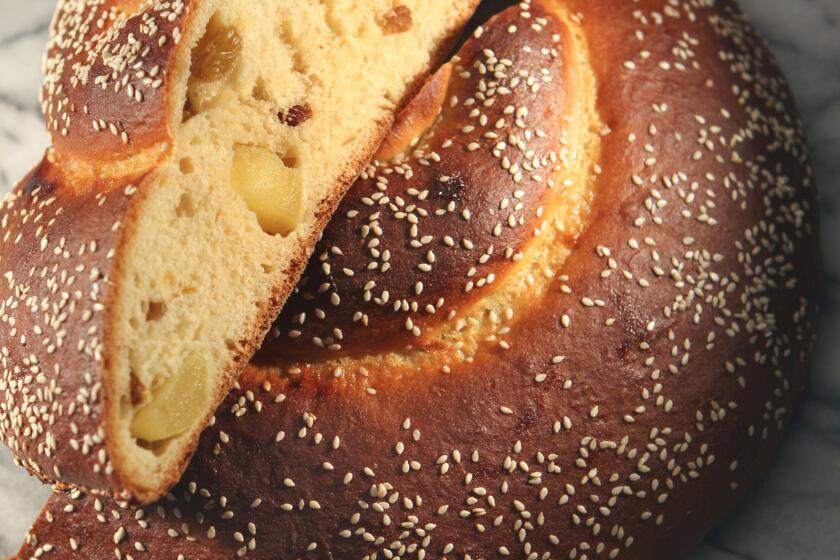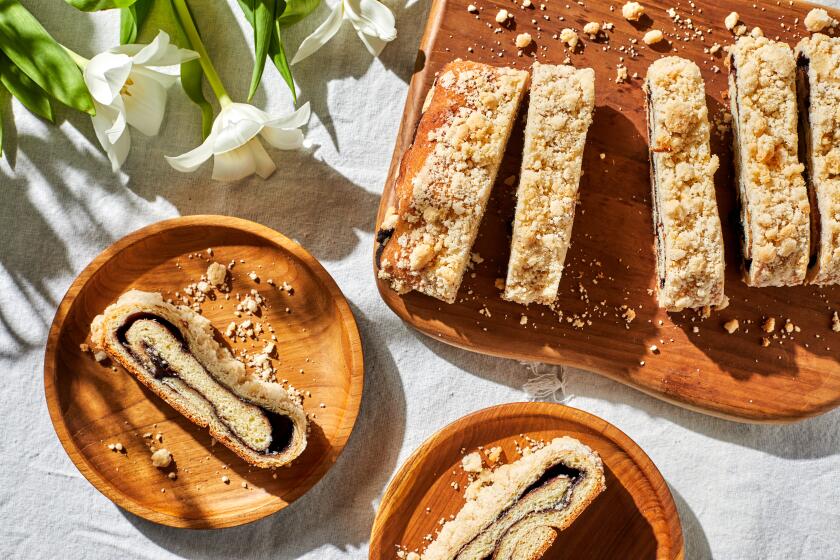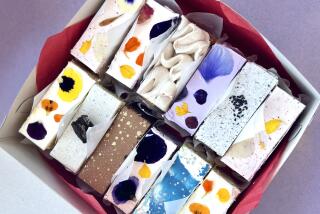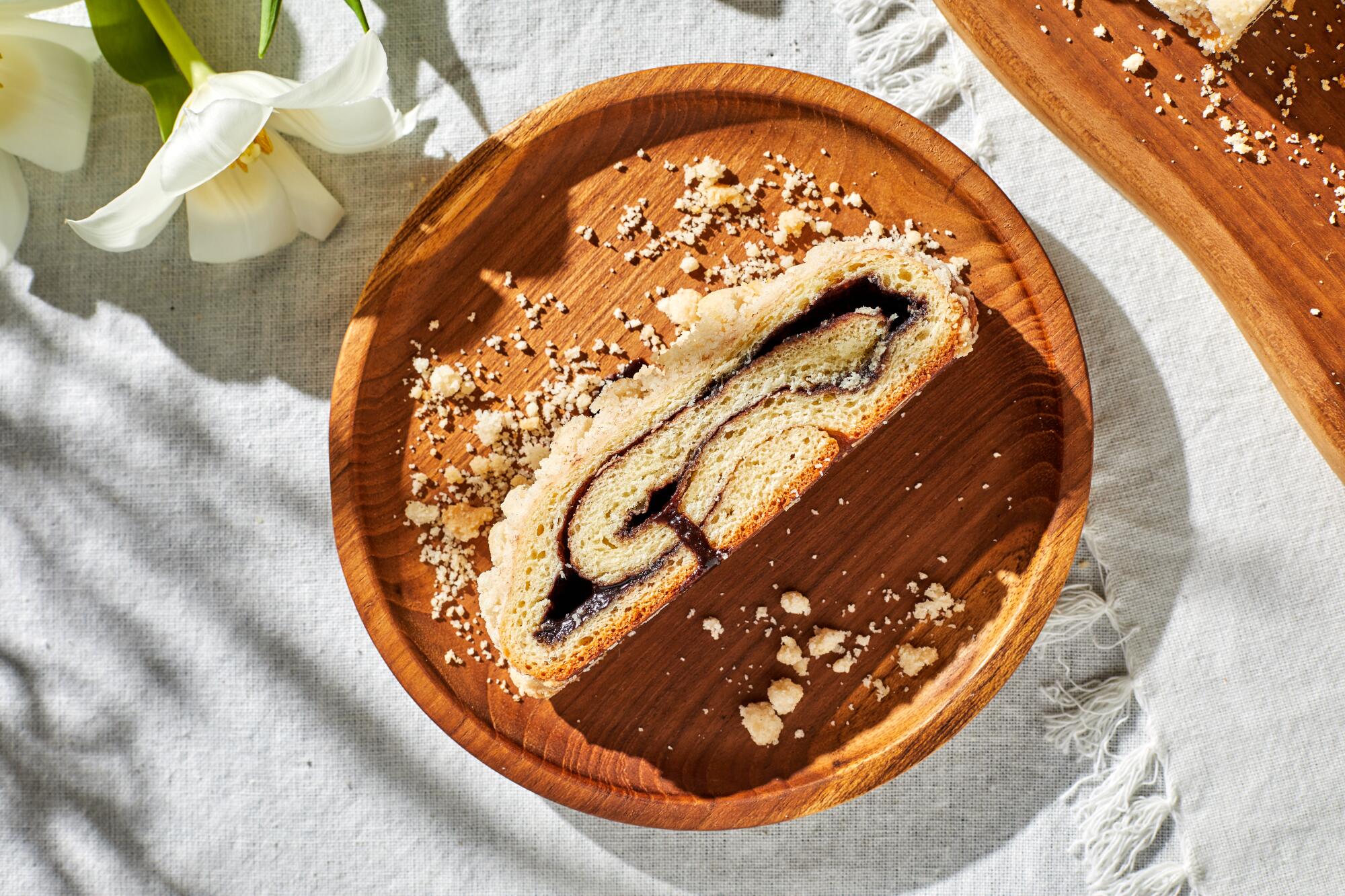
- Share via
Last year, I was invited to my first breaking of the fast for Yom Kippur and was asked to bring a dessert. Because I had never taken part in any Rosh Hashanah or Yom Kippur meals, I asked my host and friend Sam what I should bring. “Anything,” he said, “there are no rules!”
This gave me pause. There must be something that’s traditionally eaten to mark Yom Kippur, which takes place 10 days after Rosh Hashanah and is considered the holiest day of the year in Judaism. The holiday requires fasting from sundown on the evening before Yom Kippur to sunset the next day.
I wanted to bring something unexpected besides a honey cake, which is associated more with Rosh Hashanah than Yom Kippur. I asked other Jewish friends, and they all came back with the same answer as Sam’s.
Undeterred, I set about researching, trying my best to find something that would work. Because I was cooking for a large crowd, I decided to make three desserts with tangential connections to the holiday, as determined by the Google search “Yom Kippur desserts.” I ended up making a flourless chocolate cake, a crumb cake and a zwetschgenkuchen, a German tart made with Italian prune plums from a recipe by the always-reliable Jewish cookbook author Joan Nathan.
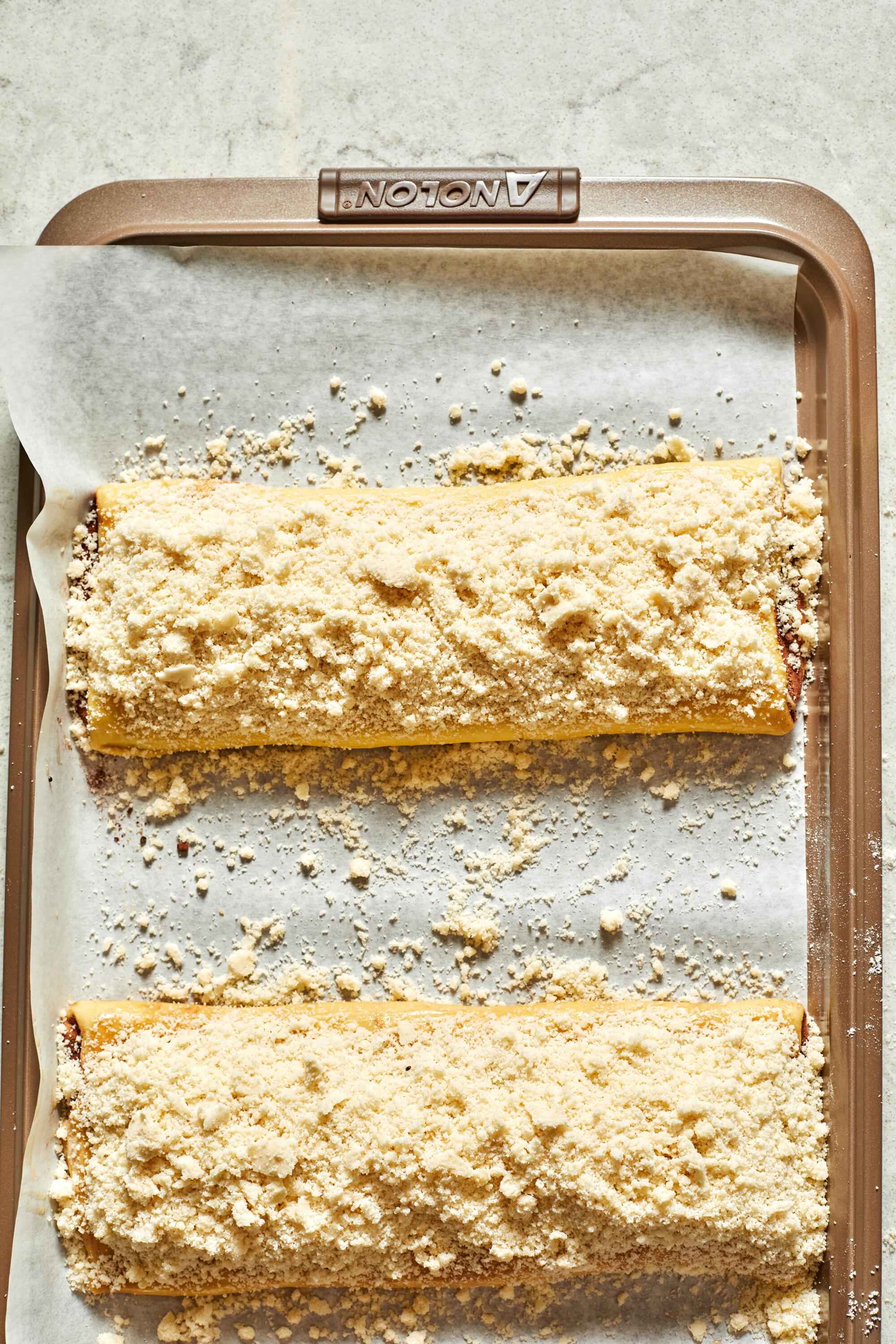
However, the chocolate cake was too dense and the crumb cake too dry — that’s what I get for taking random recipes off the internet, I guess. Thankfully, Nathan’s plum tart was perfect, and everyone had seconds of that one after politely choking down slivers of the chocolate and crumb cakes. I gave myself a full year to come up with something better, and more original, for this season’s Yom Kippur.
I reached out to my friend, New Yorker staff writer Helen Rosner, and she suggested I check out the “seven-layer cake” made by Stern’s Bakery, a Brooklyn-based wholesale bakery that supplies cakes and pastries to many of the nation’s kosher grocery stores. The seven-layer cake is essentially a rectangular version of dobos torte, a classic Hungarian dessert: seven thin layers of cake alternating with chocolate frosting and covered in melted chocolate. And while I liked the seven-layer cake, its kosher designation meant its frosting had to be shortening-based, so it had a slick quality that made it taste not unlike a “Swiss roll” snack cake from Little Debbie. This was not a bad thing, but with all the layering and chocolate coating, I wanted inspiration from a dessert that was less complicated and exacting to pull off for home bakers.
This Rosh Hashana challah is reworked from a long braid into a spiral to call to mind the cycle of life. It also incorporates apples and honey as a symbol of a sweet new year.
While shopping for the seven-layer cake, I came across another Stern’s product called heimishe kokosh. It was covered in crumbs, spiraled with chocolate and looked like a fatter and flatter version of a strudel, one of my favorite desserts. After I brought them both home, my partner and I found ourselves returning to the kokosh over and over again, for breakfast, an afternoon snack and dessert. It was just barely sweet, chewy and gooey but not decadent, and had plenty of crunch from the crumbs on top. This was the cake I wanted for my “official” Yom Kippur dessert.
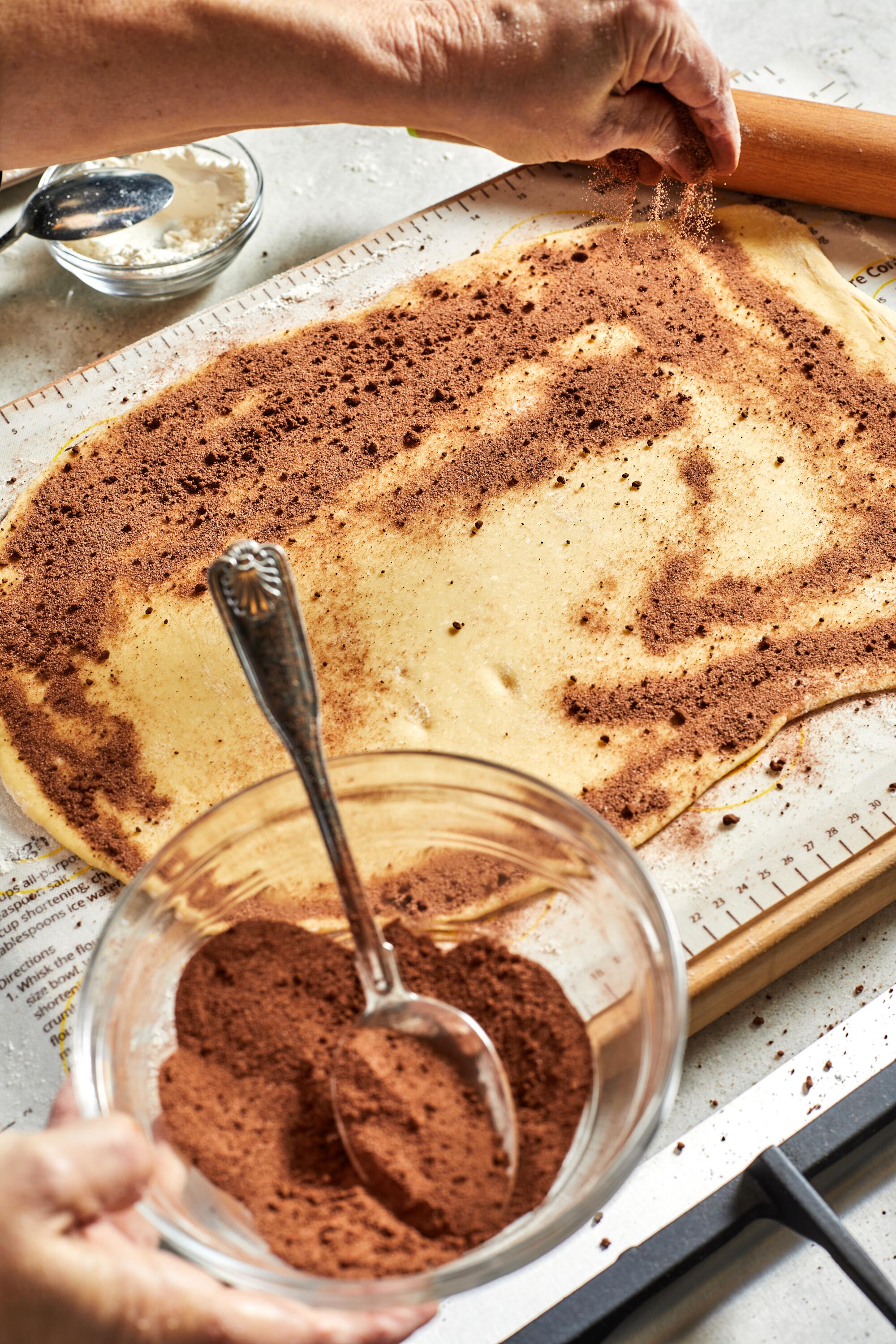
Babka meets strudel
Sometimes referred to in Jewish bakeries as “chocolate-filled rolled strips,” kokosh — Hungarian for “cocoa” — is basically a mix between babka, which is often layered with chocolate, twisted and loaf-shaped, and strudel, which is a long loaf of thin pastry wrapped around a cooked filling. It looks more like a strudel, but the dough is yeast-raised and short, which means it has a high fat-to-flour ratio from the addition of butter. It is rolled with a chocolate filling into a spiral log that’s then baked golden brown. In Hungary, kalács are yeast-raised cakes; the name comes from Slavic koláč, which comes from kolo, meaning circle.
Other Eastern European relatives of kokosh can be found in the Polish makowiec, a cake made with yeasted short dough spiral-rolled with poppyseeds and raisins that’s then baked in a log and iced. There is also Czech koláče and Polish kolache — both sometimes referred to as “Bohemian buns” — that are yeasted sweet buns filled with poppyseed or fruit filling that are then topped with a crumble topping. This is one of the few times you see a crumb topping added to such yeasted, filled cakes. The other instance is with, specifically, the “heimishe” kokosh made by Stern’s. Why the name?
Various Eastern European cakes would seem to become “coffee cakes” with the addition of high-sugar crumb toppings or a mixture of sugar and nuts that creates a crunchy contrast to yeasted or egg-risen cake batters. This stands in opposition to the “fine” cakes that were uniformly smooth in texture and filled or glazed for dessert preparations. In Germany, crumb coffee cakes, or streuselkuchen, were and are still made by sprinkling a crumb topping over a basic yeast-raised sweet dough.
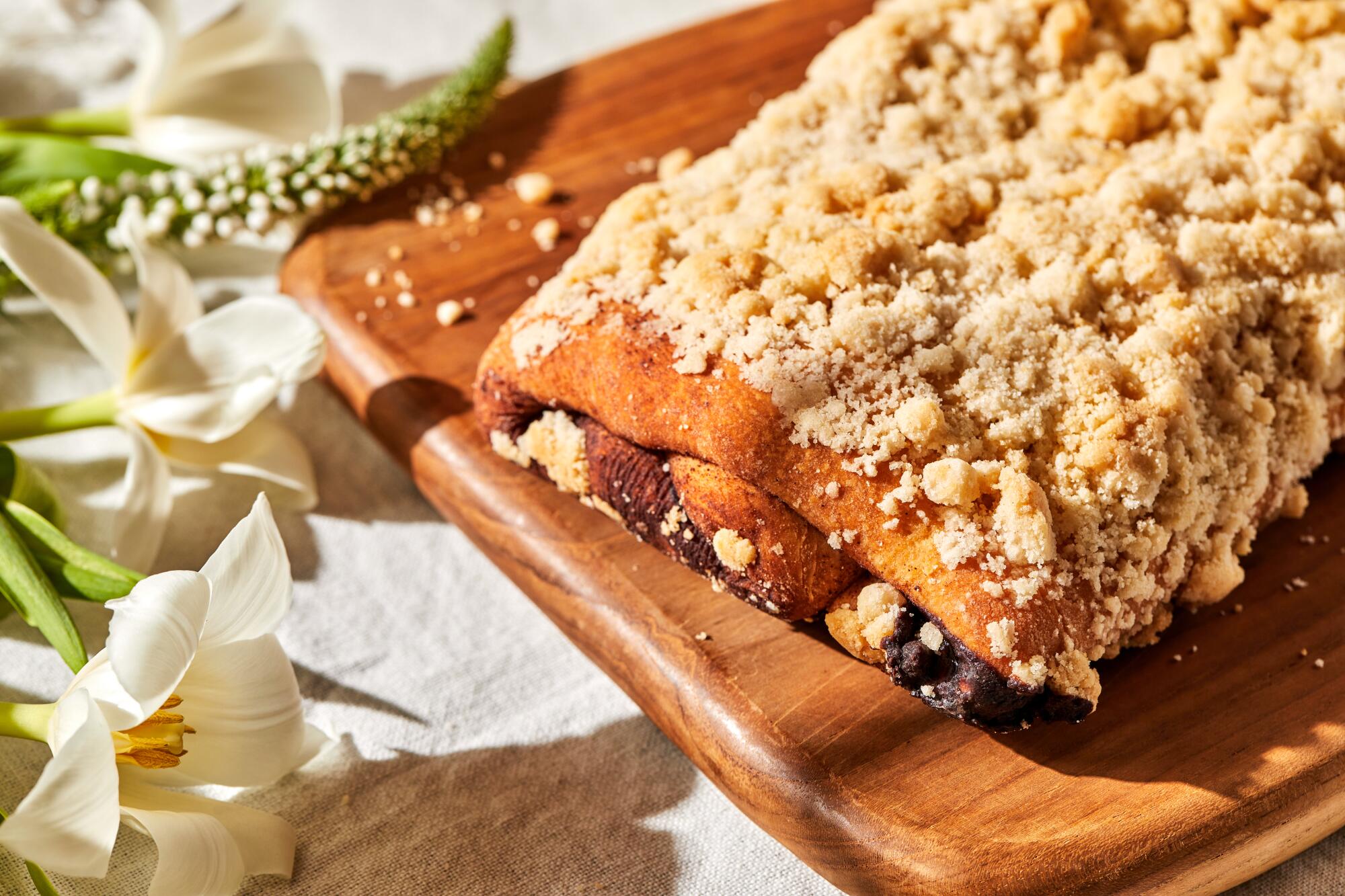
“The word heimishe is basically Yiddish for ‘homemade or kinda home-style,’” says Menashe Stern, part of the Stern’s Bakery family. “It’s really a name we give to our kokosh that has that extra gooey chocolate filling. No matter how many requests we get for gluten-free, sugar-free, all the ‘frees,’ we always sell the most of our really decadent, hardcore chocolate baked goods like kokosh and rugelach — nothing sells better.”
So, it seems that adding a crumb topping — something that’s not a given in all kokosh — preslicing and an extra gooey filling give kokosh that homey feel from the perspective of the bakers at Stern’s, which I find delightful.
According to “The Newish Jewish Encyclopedia” by Stephanie Butnick, Liel Leibovitz and Mark Oppenheimer (Artisan, 2019), kokosh is simply the Hungarian Jewish version of babka that is often baked flat and, sometimes, without streusel — this has led to kokosh’s nickname by many Jews being “flat babka.” And according to “Iconic New York Jewish Food: A History and Guide With Recipes” by June Hersh (American Palate, 2023), the bread/cake hybrid we know now as babka was first called kokosh by Hungarian Jewish immigrants who baked it in New York City.
In many ways, I view kokosh as the home cook’s version of babka, since the latter’s complex braiding and twisting is best left to the professional bakeries. But at home, where you don’t have to worry about precision, the kokosh’s charms shine. It’s a purposefully flat cake — thanks to not having to let the shaped loaf rise a second time — that eats like a sweetened bread, which is the ideal breakfast. And the heimishe kokosh’s crumb topping adds plenty of texture and sweetness to counteract the deliciously bitter cocoa filling.
In doing more research, I found kokosh to be strikingly similar to Hungarian baigli, which is a yeast-cake roll filled with poppy seed filling. Poppyseeds were cheaper than chocolate back in the late 1800s and early 1900s, so one theory is that a cocoa version of baigli came about later and it was given the name kokosh to distinguish it from the original poppyseed baigli.
Whereas some recipes for kokosh — and there aren’t that many — call for rolling the dough up into a log and baking it, I prefer the slouchy, flat shape of Stern’s kokosh. My friend Leah Koenig — author of many Jewish cookbooks, including this year’s “Portico: Cooking and Feasting in Rome’s Jewish Kitchen” (W.W. Norton) — has the best recipe I found for kokosh, rolling it into a cylinder and brushing it with egg wash before baking. While her dough serves as inspiration for this recipe, I prefer to fold the dough into wide, flat sheets rather than a tight roll because it provides a wide canvas for the crumb topping. I use a more generous amount of crumbs than even the Stern’s version displays because more crumbs are never a bad thing in my book. Once baked, you can cut the kokosh into long finger-shaped planks that are perfect for resting alongside your morning or afternoon cup of coffee.
Kokosh is decidedly less rich than all of the aforementioned sweet, yeasted breads because it is often kosher, so it doesn’t contain butter or dairy, like milk or sour cream, as many other of these yeasted roll cakes do. But this is precisely why I love it for breakfast so much — it feels like a treat you can eat with coffee and not be left feeling like it will ruin the rest of your day.
In this way, it’s the ideal way to break the Yom Kippur fast, giving you just a taste of sweetness.
Get the recipe:
Extra-Crumb Kokosh Cake
More to Read
Eat your way across L.A.
Get our weekly Tasting Notes newsletter for reviews, news and more.
You may occasionally receive promotional content from the Los Angeles Times.
